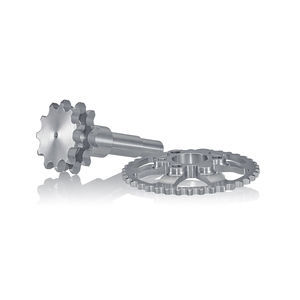
- Power Transmission - Mechanical components
- Mechanical Transmission
- Spur gear
- Zahnradfabrik Hänel GmbH & Co. KG
- Products
- Catalogs
- News & Trends
- Exhibitions
Spur gear helicalshaft


Add to favorites
Compare this product
Characteristics
- Type
- spur
- Teeth
- helical
- Other characteristics
- shaft
Description
Spur gears, also known as cylindrical gears, are the gears most commonly used in gear units. Their main feature is a relatively simple design. Smaller or larger numbers of spur gears can be installed in gear units. These may require few moving parts, depending on the specific application and requirements – in contrast, for example, to ring gears in planetary gear units or worm gear units.
Spur gears have evenly spaced teeth around their circumference for intermeshing with other gears. Gear combinations for spur gears can be produced in different versions and sizes which are called modules.
A spur gear is ultimately used in a cylindrical gear unit. The simplest and most common design is the single-stage gear unit in which two gears are mounted on a shaft. When more gears and intermediate shafts are added, the result is a multistage gear unit.
Gears are also classified by their tooth angle – the pattern of the teeth can be straight, helical, or even double helical. In the case of the straight version, 1 to 3 teeth are normally engaged at one time. To transmit sufficient power, a tooth must always mesh with its counterpart.
Often, however, helical gearing is used – for example, to reduce noise. The meshing of spur gear is much smoother and the length of the path of contact is longer.
Helical gears have one disadvantage: Lateral forces are generated that have to be structurally supported by bearings in the cylindrical gear unit.
Exhibitions
Meet this supplier at the following exhibition(s):

Other Zahnradfabrik Hänel GmbH & Co. KG products
Products
Related Searches
- Straight-toothed sprocket wheel
- Helical gear
- Spur gear
- Metal sprocket wheel
- Chain sprocket wheel
- Steel sprocket wheel
- Shaft gear
- Precision shaft
- Cylindrical gear
- Precision gear
- Single shaft
- Stainless steel gear
- Internal gear
- Transmission gear
- Transmission shaft
- Drive shaft
- Stainless steel sprocket wheel
- Single sprocket wheel
- Triple sprocket wheel
- Flange sprocket wheel
*Prices are pre-tax. They exclude delivery charges and customs duties and do not include additional charges for installation or activation options. Prices are indicative only and may vary by country, with changes to the cost of raw materials and exchange rates.










